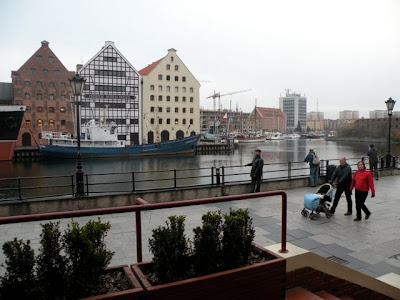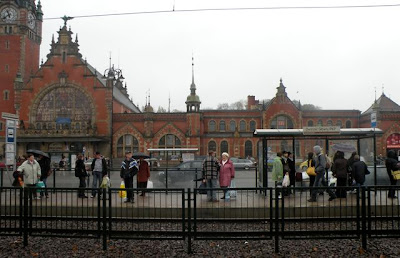The train passes through some railways stations and stops at others. As it comes closer to a station, more buildings appear, and on the buildings, a seemingly endless band of graffiti that looks as though it has simply continued on from Latvia and Russia. The graffiti is indiscriminate and snakes across everything in its path - ugly soviet housing blocks, beautiful historic buildings, private houses, brand new office blocks. And while the text may be different because it is in a different language, the formal elements of the graffiti - its style, scale and range of colours – are virtually the same as in Riga, Moscow, Warsaw – and later in Szczecin, Leszno, Berlin, Hannover, Geneva, Milan, Naples, Pompei... As the trip progresses, my disdain for its persistence and its complete lack of discrimination, in particular when it smears the base of stunning historic buildings, grows stronger and stronger.
I arrive at Gdansk and catch a cab to the Hanza hotel, which is where Michael Pallin stayed when he was filming his series on Europe. It’s not a very big hotel but it’s right on the Motlawa Canal in the centre of the old town. I’m sure Pallin’s room would have had a view across the water – mine, however, looks over the street. I am also convinced I have been given the wheelchair accessible room because it is the only room in the hotel with a giant sized door (I know this because one morning I walk down all the corridors on all the floors in the hotel and check the size of all the doors to the rooms – mine is the only one of such large proportions). My bathroom is also huge and has convenient handrails next to the toilet and in the shower.
On my first evening I take a walk along the picturesque waterfront which is lined with amber shops and restaurants. Right next door to the hotel is the famous Zuras crane, a giant Medieval wonder of engineering that was originally built in the 14th century. For centuries it was used to load and unload cargo from ships but now it is part of Gdansk’s maritime museum. I stop to admire the amber shops every now and then. There are so many here that I can barely believe it – shop after shop after shop, all selling every type of amber jewel imaginable. I thought there was a lot of amber in Riga, but here, there are entire streets that are just amber stores, like the beautiful Mariacka Street.
I reach the Dlugi Targ, the main ‘square’ of the old town which was once the ‘Royal Road’ and is entered at either end through ancient gateways. Like Warsaw, Gdansk was reduced to rubble during WWII and was completely rebuilt, brick by brick. I have a friend who dislikes the rebuilding of cities destroyed as the result of war and sees it as a type of Disneyefication of place, but I don’t agree. I am stunned at the sheer amount of work, the extraordinary attention to detail and the almost defiant dedication that must have been required to reconstruct what I see now, as I walk through the square. I am entranced by the buildings – I can’t imagine them scarred by war – they feel like they have been here, settling and weathering, since they were first erected. Most of them have steps that lead to their entrances, flanked by fabulous gargoyle drains. I stroll from one end of the square to the other and I feel really happy to be here – it’s much easier and friendlier in terms of scale than Warsaw. I have a friend back in Hobart who is half Polish and I wish I could beam her down to enjoy Gdansk with me - I am convinced she would just love it. I have coffee in a smart café that also offers mouth-watering cakes and ice-cream before heading back to the hotel in the dark.
The next day I walk to the Roads to Freedom, or Solidarity Museum, which tracks Polish resistance to Soviet occupation from the end of WWII. I am very moved by the exhibits and find myself spontaneously crying as I walk through the rooms. The crying response started back in Riga and has been with me ever since. It starts without any conscious invitation and makes me weep with embarrassing profusion at the slightest trigger. But I can’t pin down the nature of the trigger – sometimes I go somewhere and fully expect the crying response to kick in – a cemetery, for example, where a relative is buried - but no, not a single tear. At others, I just have to glance at a small object or a stranger’s face and the weeping starts instantaneously. In this museum, it’s all bound up with the focus on the 1980 dockworkers’ strikes - I am overwhelmed by the images, objects, soundtracks and reconstructions that represent the fight for civil rights, the determination of everyday individuals to resist oppression. I even weep at the giant plastic souvenir Pope pen that was used to sign the strike conditions, even though it looks almost comical displayed in its own glass case.
 The entrance to the underground Solidarity Museum
The entrance to the underground Solidarity Museum Inside the Solidarity Museum
Inside the Solidarity Museum The Pope pen and the conditions of the strike
The Pope pen and the conditions of the strike* * *
I need to find the port where my mother’s ship would have landed in 1944 and I ask the receptionist at the hotel if she knows where it is. She gives me instructions to catch tram number 8 and tells me that will take me there – she is quite specific and even marks the direction of the tram on my map. She actually sends me on a wild goose chase – I take tram number 8, excited at the prospect of arriving at the old port, but the tram just goes deeper and deeper into Soviet housing block areas. It’s all very interesting, but after about 45 minutes, I get out, cross the tram tracks and go back to where I came from. I stop at the Solidarity memorial where the 1980s dockworkers’ strikes took place (here there is no weeping) and then head back into town.
Just opposite the railway station is a Holiday Inn and I ask the staff here for the location of the old port. This time I get good information – I have to go to Westerplatte, where WWII started, which is on a peninsula opposite the new wharf. There is no easy way to get there at this time of year because the tourist season is over. During the summer, there is a boat that takes you there (how perfect that would have been) but now the choices are limited and I decide to hire a cab. I go back to my hotel and they arrange for a driver to take me on a round trip to Westerplatte.
My cab driver, Roman Zagorski, arrives in his Mercedes. He speaks English well and also has a great sense of humour. He’s a bit round and jolly and when he laughs, reveals a great row of small, dolphin-like teeth. But he also takes the journey seriously and assumes the role of personal tour guide. He knows Westerplatte intimately and shows me all the significant sites, including the spot where WWII started, of course.
We drive around small roads where there are many old factories. We stop so I can take photographs. I get out and walk on the sandy beach and watch the waves roll in from the Baltic Sea. Roman has worked out a little itinerary for me that would take me on a ferry to the other side of Westerplatte peninsula but unfortunately, the ferry is not operating today. We are both a bit disappointed. He shows me where the ships would have come in during the war and I try to imagine what it was like for my mother and her family to arrive here, in a strange land, on a ship that had been bombed carrying a cargo of wounded soldiers and refugees. Did they know they were going to Gdansk? Or did they just get on the ship and hope that it would take them away from the encroaching Soviet advance? They would have known, of course. My mother tells me later that my grandfather’s cousin, who was the one who had arranged for them to go by train to Liepaja, was looking after the wounded soldiers and had to accompany them to Gdansk. He was allowed to take his family with him, but as he was single, and my grandfather was his closest relative in Riga, he asked my mother’s family if they wanted to go. They did. They made the decision to leave instead of staying.
I wonder what my mother’s life would have been had they stayed – how would communism have treated her and what opportunities would it have offered? Would she be living now in a Soviet housing block in the outer suburbs of Riga, in a tiny flat with paper thins walls, growing all her own vegetables and flowers in a community garden? It seems futile to think about this, because had she stayed, I would undoubtedly not exist and nor would the questions. The fact is, my mother left her homeland and went to Australia and she now lives in the Latvian Retirement Village in a small but sunny unit with Mr Chips, the most beautiful dog that could possibly be, and a very lovely garden that she takes great pride in tending.
Nevertheless, I feel a desire to spend more time here, to sit here on the sandy beach, look out over the Baltic and just take in where I am and how far away it is from little Hobart on the other side of the earth. But it’s also cold and windy and I’m with Roman, and the meter in his Mercedes is ticking away as he smiles at me with his dolphin teeth and suggests some further extensions to our trip. I thank him and say I have seen enough and he drops me off near the main street of the old town.
On my final night in Gdansk, I catch a cab to the Szydlowski Hotel, which is where Gunter Grass, the Nobel-Prize winning author of Tin Drum stays whenever he is in town. Gdansk, of course, is his home and in this hotel he has a table permanently booked in the restaurant. I decide I should eat a meal there – who knows, perhaps Grass himself may turn up. The hotel is about fifteen minutes drive from the old town and it’s a smart but fairly modest 3 star establishment. I ask at reception if this is where Gunter Grass stays and they tell me yes, there is a picture of him in the café, where he sometimes dines. I take a seat and order Polish sour soup, which is served in a hollowed-out loaf of rye bread. It’s just delicious – very similar to Latvian sour soup, but Latvians don’t serve it inside a loaf of bread. It’s made from sorrel, boiled eggs and chunks of bacon and has a distinctive sour flavour. I take photos of my dinner, ask the waitress to take a photo of me sitting in the Gunter Grass cafe and then take a cab back to the old town. The next day I catch another train and head deeper into the Polish coutryside in search of the camp in Stargard Szczecin.












No comments:
Post a Comment